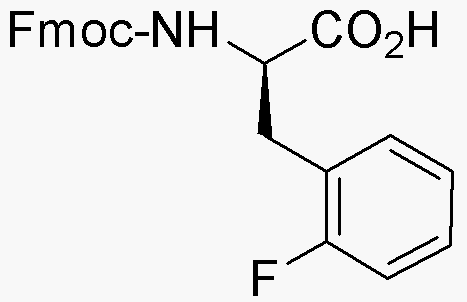Fmoc-2-fluoro-D-phenylalanine is widely utilized in research focused on:
- Peptide Synthesis: This chemical is a key building block in the synthesis of peptides, particularly in solid-phase peptide synthesis (SPPS). Its protective group allows for selective reactions, making it easier to assemble complex peptides.
- Drug Development: The incorporation of fluorine in drug candidates can enhance their pharmacological properties. This compound is used in the design of novel therapeutics, particularly in targeting specific biological pathways.
- Bioconjugation: Fmoc-2-fluoro-D-phenylalanine can be employed in bioconjugation techniques, linking peptides to various biomolecules such as antibodies or enzymes, which is essential for developing targeted drug delivery systems.
- Research in Neuroscience: This compound is valuable in studying neurotransmitter systems, as it can mimic natural amino acids, allowing researchers to explore the effects of modified peptides on neuronal activity.
- Analytical Chemistry: Its unique properties make it useful in analytical applications, such as chromatography, where it can help in the separation and identification of complex mixtures in biological samples.
General Information
Properties
Safety and Regulations
Applications
Fmoc-2-fluoro-D-phenylalanine is widely utilized in research focused on:
- Peptide Synthesis: This chemical is a key building block in the synthesis of peptides, particularly in solid-phase peptide synthesis (SPPS). Its protective group allows for selective reactions, making it easier to assemble complex peptides.
- Drug Development: The incorporation of fluorine in drug candidates can enhance their pharmacological properties. This compound is used in the design of novel therapeutics, particularly in targeting specific biological pathways.
- Bioconjugation: Fmoc-2-fluoro-D-phenylalanine can be employed in bioconjugation techniques, linking peptides to various biomolecules such as antibodies or enzymes, which is essential for developing targeted drug delivery systems.
- Research in Neuroscience: This compound is valuable in studying neurotransmitter systems, as it can mimic natural amino acids, allowing researchers to explore the effects of modified peptides on neuronal activity.
- Analytical Chemistry: Its unique properties make it useful in analytical applications, such as chromatography, where it can help in the separation and identification of complex mixtures in biological samples.
Documents
Safety Data Sheets (SDS)
The SDS provides comprehensive safety information on handling, storage, and disposal of the product.
Product Specification (PS)
The PS provides a comprehensive breakdown of the product’s properties, including chemical composition, physical state, purity, and storage requirements. It also details acceptable quality ranges and the product's intended applications.
Certificates of Analysis (COA)
Search for Certificates of Analysis (COA) by entering the products Lot Number. Lot and Batch Numbers can be found on a product’s label following the words ‘Lot’ or ‘Batch’.
*Catalog Number
*Lot Number
Certificates Of Origin (COO)
This COO confirms the country where the product was manufactured, and also details the materials and components used in it and whether it is derived from natural, synthetic, or other specific sources. This certificate may be required for customs, trade, and regulatory compliance.
*Catalog Number
*Lot Number
Safety Data Sheets (SDS)
The SDS provides comprehensive safety information on handling, storage, and disposal of the product.
DownloadProduct Specification (PS)
The PS provides a comprehensive breakdown of the product’s properties, including chemical composition, physical state, purity, and storage requirements. It also details acceptable quality ranges and the product's intended applications.
DownloadCertificates of Analysis (COA)
Search for Certificates of Analysis (COA) by entering the products Lot Number. Lot and Batch Numbers can be found on a product’s label following the words ‘Lot’ or ‘Batch’.
*Catalog Number
*Lot Number
Certificates Of Origin (COO)
This COO confirms the country where the product was manufactured, and also details the materials and components used in it and whether it is derived from natural, synthetic, or other specific sources. This certificate may be required for customs, trade, and regulatory compliance.


